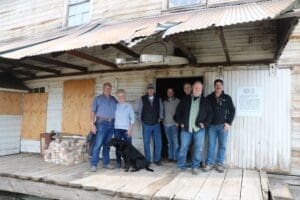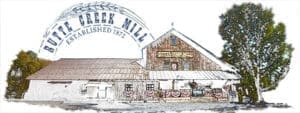Keller Mill Donated To Butte Creek Mill
Published on November 15, 2017
Built in1871 the State Line Milling Company Grist Mill (Keller Mill) has been donated to the Butte Creek  Mill.
Mill.
The Keller Mill was a water-powered grist mill operating for years in New Pine Creek, Oregon which straddles the Ore/Cal border south of Lakeview.
A tour was done a couple weeks ago and we can’t thank Whit and Margaret Simpson enough for giving two old mills a new life.
Here is a great Q and A with George Kramer on what the donation means to the Rebuild the Mill project and the Butte Creek Mill Foundation.
BUTTE CREEK MILL RECONSTRUCTION
Q&A Keller Mill, in New Pine, OR
from G. Kramer (November 2017)
Q: What value is there in dismantling the timber frame and other elements of the Keller Mill for use in the restoration of the Butte Creek Mill?
A: The Keller Mill, built in 1871, has a heavy frame of hewn timbers that is very similar in both age and character to the Butte Creek Mill. Huge beams and columns have “adz” marks, as they were hand hewn from solid logs into beams, mortises and notches, from their own installation and, in some cases, re-use, and an aged patina of a century and half of use. Other material, floorboards and decking, show the worn pattern of water-powered sawmills, or the wear of workers and time. Salvaging and reusing these elements allow the reconstructed mill to maintain a sense of authenticity and a patina of age that is simply not possible with new materials. From the simple utility of the re-used beams and columns, to the character of the saw marks and the “sheep-polishing,” the signs of repetitive motion on the stair treads and floorboards, materials from of the Keller Mill will provide the look and feel of decades of use that will add immeasurably to the historic character of the rebuilt Butte Creek Mill.
Q: What is the value of the milling equipment of the Keller Mill for use in the restoration of the Butte Creek Mill?
A: The Keller Mill is filled with beautiful, high-quality, milling equipment from the early 1900s. This includes wooden sifters, roller mills, dressers, and other very high-end equipment. Not all of this is needed for the function at the Butte Creek Mill. But the Keller Mill is also filled with wooden chutes, drive wheels (both wood and iron), control devices, furnishings (desk/stools, a workbench) and other things that are not only typical of early milling operations but in some cases virtually identical to features that were present at the Butte Creek before the fire. These elements can be salvaged and reused to replicate lost features or the Butte Creek Mill, or in the case of the workbench, for example, used as display features in the sales area, adding to considerably the interior character.
Some of the milling equipment, such as the chutes and drive belts of the Keller Mill, can be used to reactivate the milling process at Butte Creek in an authentic manner. Other equipment, such as the sifter and the roller mills, while not necessary for the operation at Butte Creek, have incredible interpretative value for the milling-history/educational program envisioned for Butte Creek and, in some cases decorative value that will add to the Butte Creek Mill experience. Still other excees elements may have sale value, not only rare equipment to support other historic milling operations nationwide, but yielding potential income to support the Butte Creek restoration effort.
Q: Isn’t it going to be expensive to dismantle the Keller Mill and transport and store all the material to Eagle Point? Is it worth it?
A: Although the owner of the Keller Mill has generously donated the building and all its contents free of charge, there is no doubt that carefully dismantling the mill, salvaging the heavy timbers, floorboards, siding and relocating the milling equipment won’t be cheap. The distant location, the heavy equipment and cranes that will be needed, and the several weeks of on-site labor, will come at some considerable expense. But let’s say it’s six-figures or more… that’s still far less than 10% of the estimated cost of the Butte Creek Reconstruction. The value of authentic, 100+ year-old materials to support the Butte Creek project are, literally, priceless. The availability of historic milling equipment, both for re-starting the milling operation and for interpretation, are alone worth any anticipated costs associated with the dismantling process, even before any consideration of selling off any excess equipment to support the effort. Yes, while it won’t be easy, it is certainly “worth it!”
SUMMARY STATEMENT:
The Keller Mill, in New Pine Creek, Oregon creates an incredible and unexpected opportunity for the restoration of the Butte Creek Mill, in Eagle Point. The re-use of Keller’s nearly 150-year old hand hewn timbers, floorboards and other materials, will allow us to maintain the historic patina at the Butte Creek Mill in an authentic manner than simply can’t otherwise be duplicated. The advantage of having access to century-old, milling equipment, both for actual use at the Butte Creek and to support our educational goals on the history of flour milling in Oregon, is simply beyond compare. There is no replacement for time, for the evidence of repetitive use. The goal of rebuilding the 1872 Butte Creek Mill in as authentic a manner possible is significantly enhanced by the generous donation of the 1871 Keller Mill and all of its equipment.

So will they be rebuilding the Butte Creek Mill or will it be the Keller Mill rebuilt in Eagle Point?
Hi Steve, good question. The two mills have different footprints and we are rebuilding the Butte Creek Mill to the original footprint so it will be parts of the Keller Mill that will help us create rebuild history. The floorboards and the 100 plus years of walking on them just can’t be replicated. The hand-hewn timbers from 1871 will also play an important role in the rebuild. Does that help? Thank you, Steve, we appreciate your support and keeping up with all the good news that will be flowing in.
I think this is an opportunity of a lifetime for Butte Creek Mill. A deep breath of fresh air for the beginning of the re-build of this wonderful landmark. I see no reason why anyone would question the integrity of using parts of one old mill to rebuild another. It sure is better than replacing it with new timbers. I do realize that new timbers will be needed but like rebuilding an old car. You go with original or near original whenever possible, then fill in with aftermarket/remade parts. I add my thanks to the owners . May you have a wonderful feeling during this season of Thanksgiving and Christmas that follows. Truly God Bless.
Sad for Lake County people, they love their history, too!